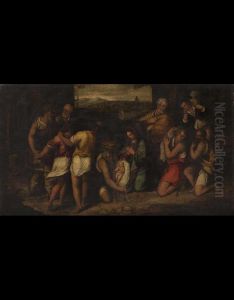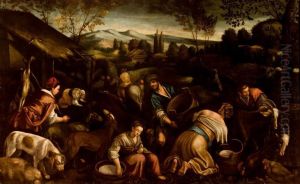Giambattista Bassano Paintings
Giambattista Bassano, also known as Giovanni Battista da Ponte or simply Bassano, was an influential Italian painter born in 1510 in Bassano del Grappa, a small town in the Veneto region of Italy. He was part of the Bassano family of painters, which included his father Francesco il Vecchio and his brothers Francesco the Younger, Leandro, and Gerolamo. The family's artistic legacy is deeply intertwined with the Venetian painting tradition of the 16th century, though they primarily worked in their native town, from which they derived their surname.
Giambattista's style evolved significantly over his career, initially influenced by his father's work and the Mannerist style that was prevalent in Italy during his early years. However, his most significant influence came from the Venetian school, particularly the works of Titian and Tintoretto, which he studied during his visits to Venice. These experiences helped him develop a rich, vibrant color palette and a mastery in depicting light, characteristics that became hallmarks of his mature style.
Bassano is best known for his religious and mythological scenes, which he often set in contemporary landscapes filled with naturalistic details. This approach not only demonstrated his exceptional skills in observation but also made the divine and mythical narratives more accessible to viewers of his time. His ability to blend biblical and pastoral themes with everyday life anticipated some of the trends of Baroque art. Additionally, Bassano was among the first Italian painters to give prominence to nocturnal scenes, using the play of light and shadow to enhance the emotional depth of his work.
Apart from religious and mythological subjects, Bassano also excelled in genre painting, depicting scenes of peasant life with warmth and dignity. His works in this genre are considered precursors to the naturalist trends that would emerge more prominently in later European art. The artist's interest in portraying the natural world extended to his studies of animals, which he depicted with remarkable accuracy and sensitivity.
Giambattista Bassano's legacy extends beyond his contributions to painting. He played a crucial role in the development of the Bassano workshop, which became one of the most prolific in Veneto. Through the workshop, his style and techniques were disseminated by his sons and followers, ensuring the continuity of his artistic vision. Bassano passed away in 1592 in Bassano del Grappa, leaving behind a body of work that continues to be celebrated for its innovation, beauty, and influence on the evolution of Venetian art.

